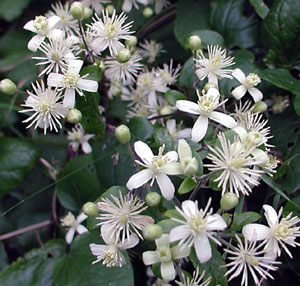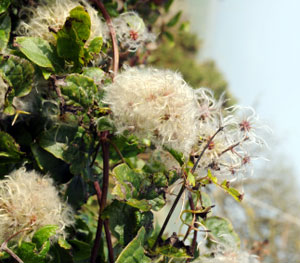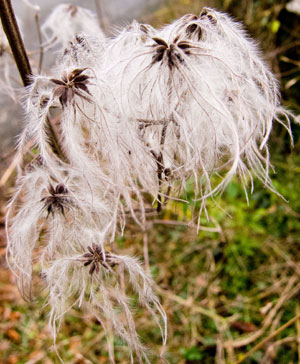Old man’s beard or traveller’s joy.
Leaves and stem
Like other members of the Clematis genus, old man's beard or traveller's joy climbs (or scrambles ) over other plants using its leaf stalks (petioles) and flower stalks. The leaves are not unlike the familiar garden forms of Clematis. The leaf stalks entwine around any convenient support / structure in their vicinity and then lignify (become woody).
The leaves are described as opposite and 1-pinnate, that is, they have one pair of leaflets opposite to each other plus one terminal leaflet (photo to follow).
As the plant grows and matures, it forms woody stems which can be as thick as a wrist; the plant can grow to a height of 40 feet or more.
Flowers and Fruits

Clematis belongs the family as buttercups, the Ranunculaceae. However, Clematis species are the only woody members of the Ranunculaceae.
The flower structure is also unusual in that the flowers of Clematis species actually have no petals! The showy, petal-like structures (for which garden species are most valued) are, in fact, sepals. There are usually four of these. Old man's beard produces many flowers, which are a soft white colour. Each is about 2 cm (¾ inch) across.
W J Bean (Trees and Shrubs Hardy in the British Isles) says that the flowers have a slight almond scent.

The flowers appear in August and September. When the plant has finished flowering, the developing seeds (known as achenes - an achene is a one seeded fruit) retain part of the flower – the style. This has long, silky hairs, which form the grey tufted balls that are so conspicuous in some woodlands and hedgerows in autumn and winter. These are, indeed, the 'old man's beard'. These silky structures are important in the dispersal of the seeds.
Ecology and other notes

Old man's beard or 'traveller's joy' - Clematis vitalba This is a vigorous climber. The French name for old man's beard is 'herbe aux gueux' – the beggar's or rascal's herb. This is a reference to its use by beggars; they used its acrid sap to irritate the skin to give it a sore and ulcerated look - in order to induce sympathy in, and perhaps a donation from, passers by!
In the UK and many parts of Europe, it may be seen in a variety of habitats such the edges of woodlands, hedgerows, or within woods where a gap in the canopy has formed; though it does tend to like chalky soils. Whilst it is fairly common in the south of England, it is less common as one goes north.
Photography : flowers – courtesy of ‘Wild Flowers of the British Isles’ : visit http://ukwildflowers.com/index.htm Floral image remains copyright of Peter Llewellyn, others of woodlands.co.uk.
Whilst we may consider old man's beard to be 'normal' plant of the hedgerow / woodland habitat, it is viewed with some alarm in places, such as New Zealand. It was introduced there as a garden plant, but its wind blown seeds soon found other homes in their woods and forests; where it grows rampantly in the canopy reducing the light that filters down to the shrub and herb layers. The sheer weight of the plant may break the supporting trees. As with invasive species here, it has to be controlled.